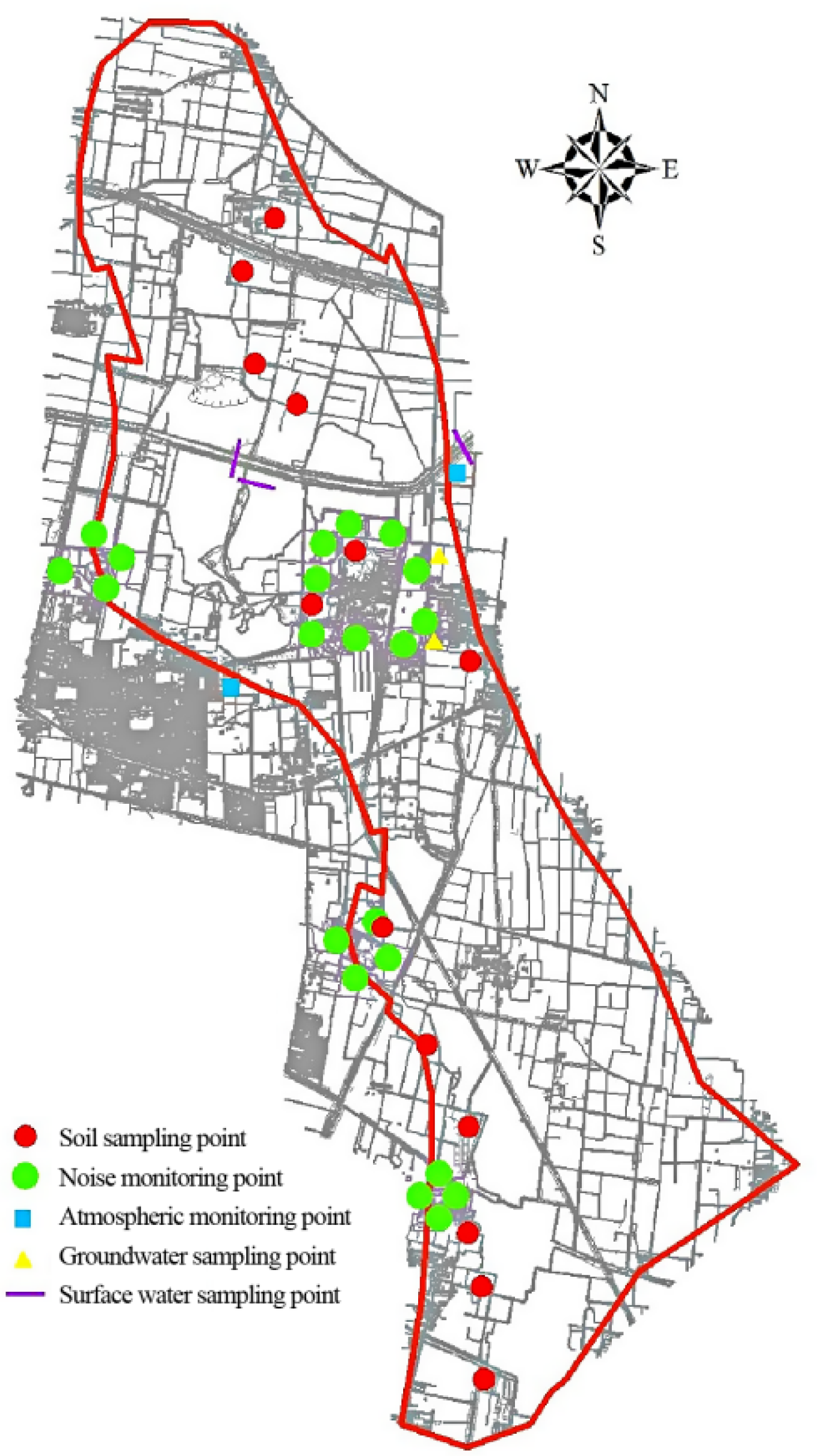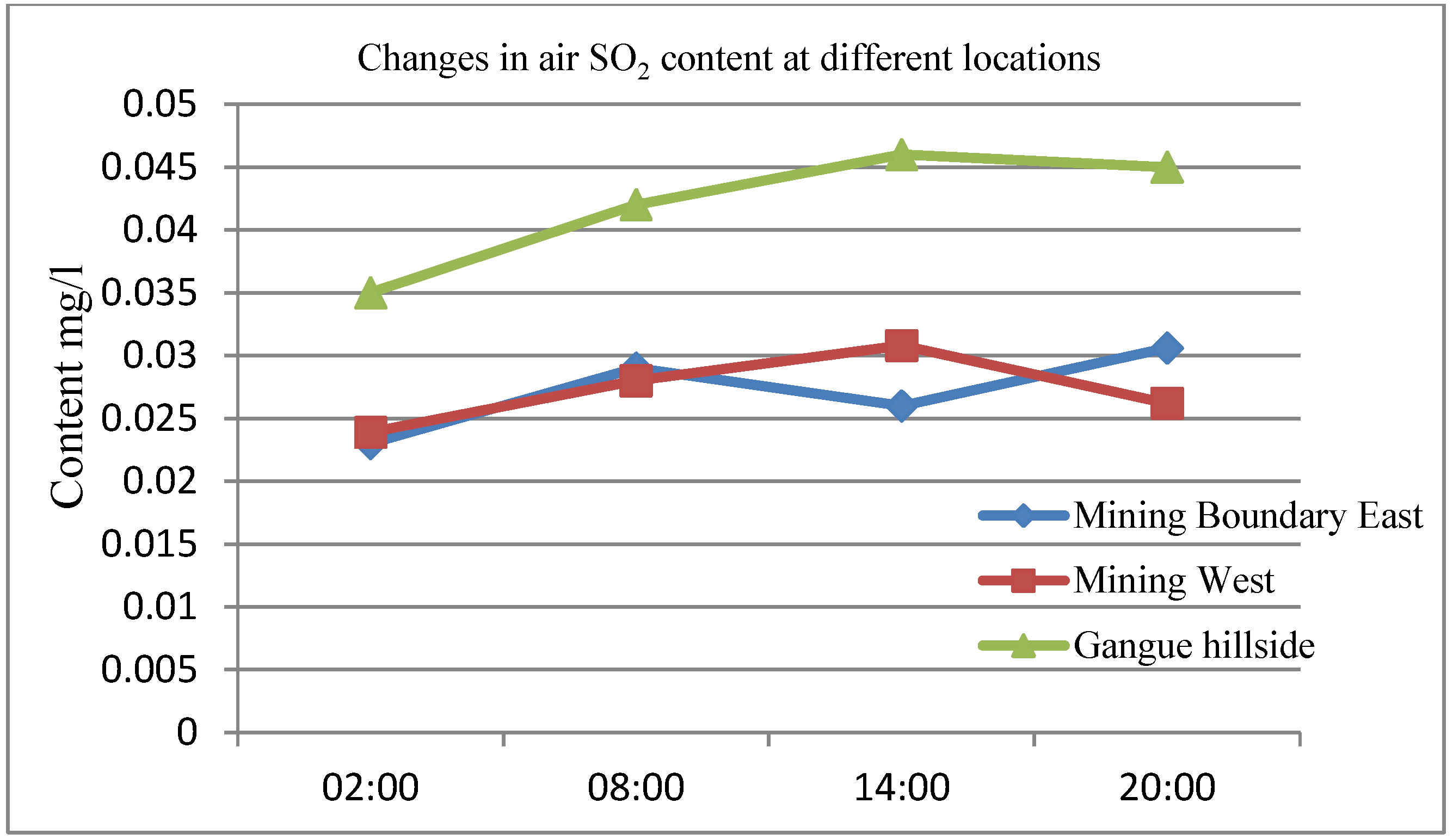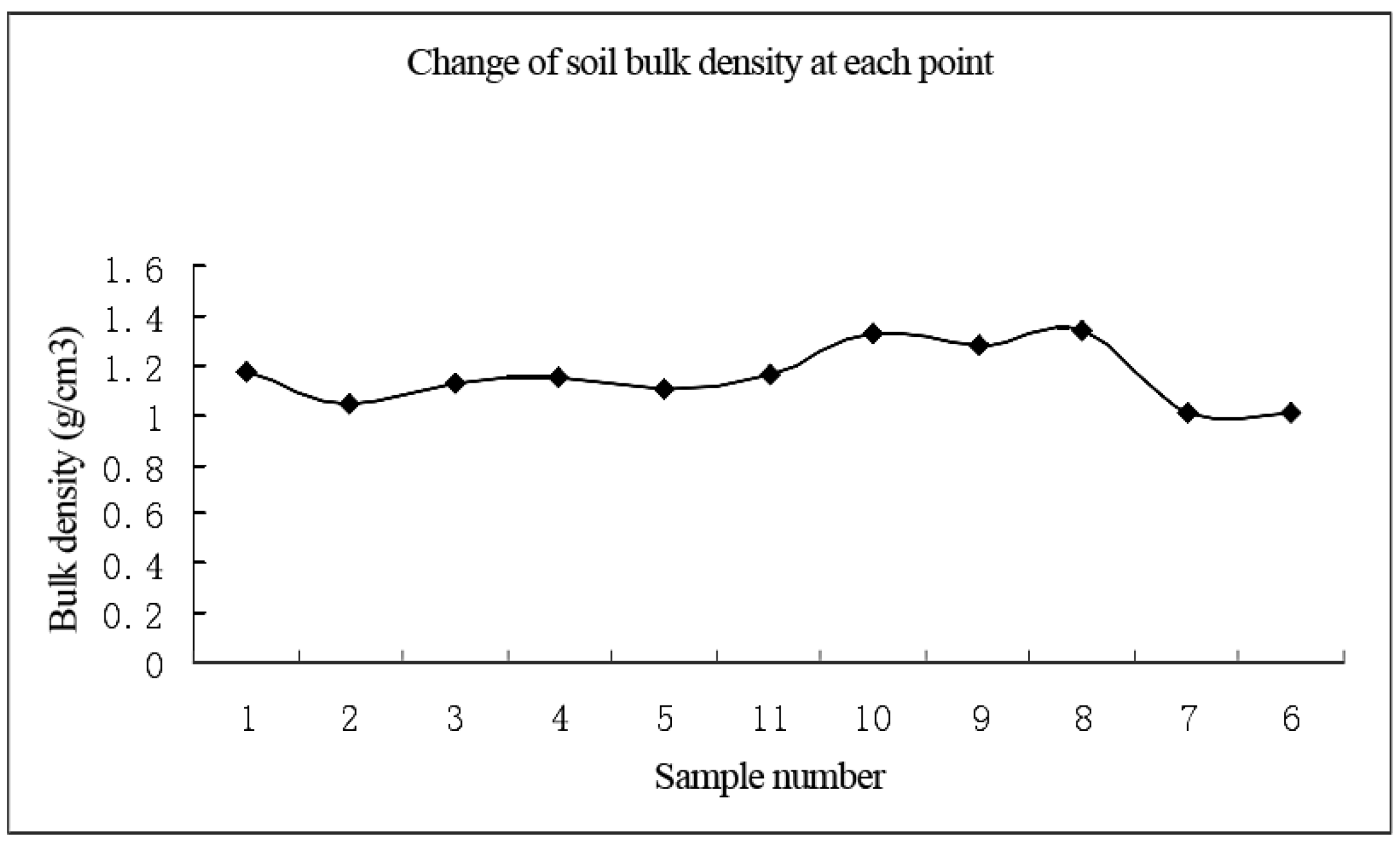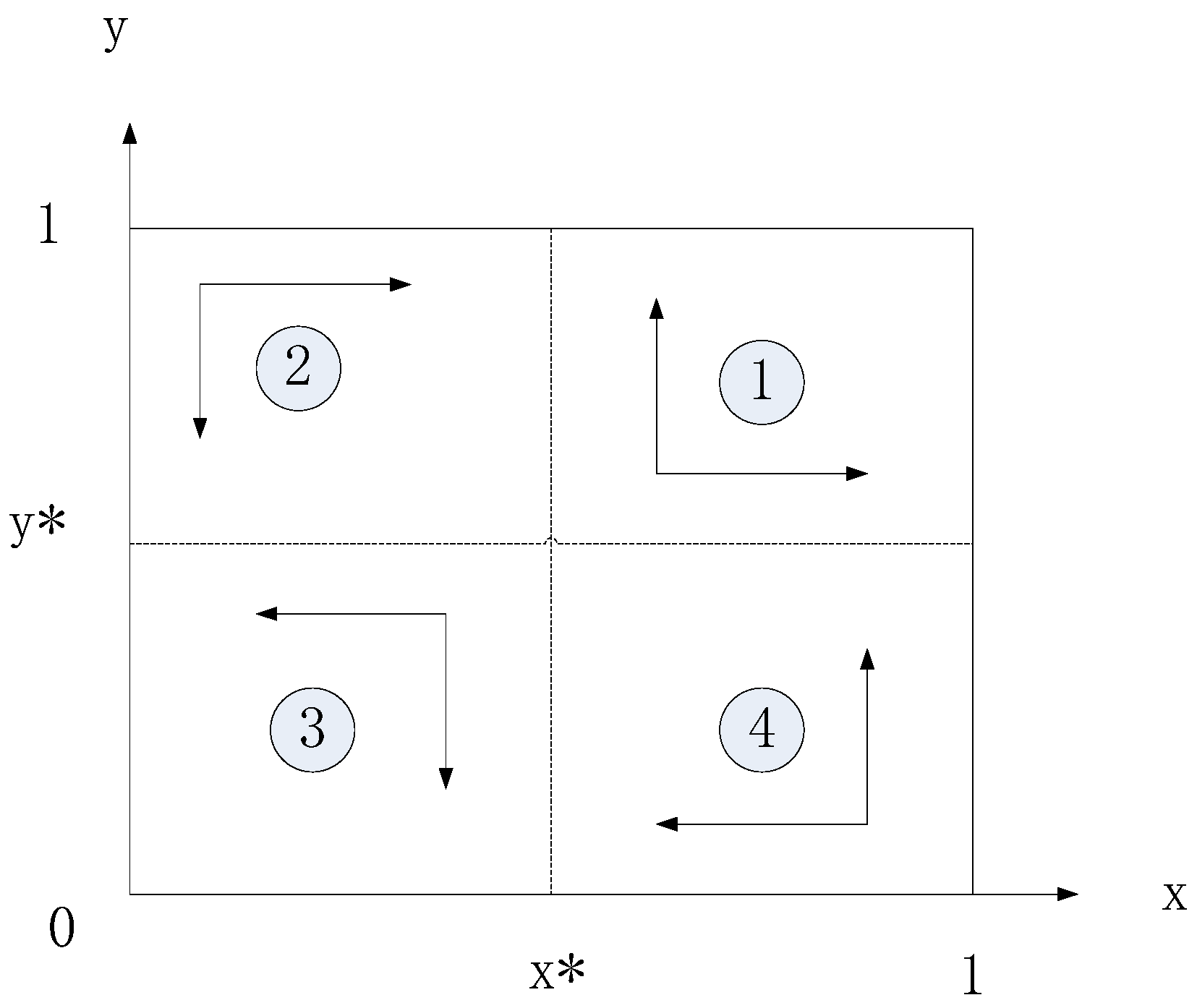Research on Ecological Compensation Mechanism for Energy Economy Sustainable Based on Evolutionary Game Model
Abstract
:1. Introduction
2. Materials and Methods
2.1. Establishment of Evolutionary Game Model
2.1.1. Participants and Strategy Selection
2.1.2. Model Assumptions
2.1.3. Model Derivation
2.2. Accounting Method of Ecological Compensation (P)
2.2.1. Layout of Monitoring/Sampling Points
2.2.2. Test Items and Methods
2.2.3. Test Instrument Selection
2.2.4. Design of Ecological Compensation of Coal Resources Mining
3. Results
3.1. Equilibrium Points and Strategy Selection of Evolutionary Game Model
3.2. Calculation of Ecological Compensation for Coal Resource Development
3.2.1. The Impact of Coal Resource Development on the Atmospheric Environment
3.2.2. The Impact of Coal Resource Development on the Soil and Surface Subsidence
3.2.3. The Impact of Coal Resource Development on the Water
4. Discussion
4.1. Analysis of Parameters and Results in Evolutionary Game Model
4.1.1. Analysis of Parameters
4.1.2. Analysis of Evolutionary Game Results
4.2. Equilibrium Results of Game Model in Specific Cases
5. Conclusions
5.1. Ecological Compensation Types
5.1.1. Resource Depletion Compensation Mechanism
5.1.2. Environmental Restoration Compensation Mechanism
5.2. Ecological Compensation Threshold
5.2.1. Strictly Implement the Elimination Mechanism of Declining Industries
5.2.2. Promote Technological Innovation Compensation Mechanism
5.2.3. Weaken the Government Subsidy Mechanism and Strengthen the Initiative of Enterprise for Ecological Compensation
5.2.4. Rely on Non-Governmental Organizations to Enlarge the Social Benefits Brought by Government Regulation
Author Contributions
Funding
Institutional Review Board Statement
Informed Consent Statement
Data Availability Statement
Conflicts of Interest
References
- Acheampong, A.O.; Boateng, E.; Amponsah, M. Revisiting the economic growth–energy consumption nexus: Does globalization matter? Energy Econ. 2021, 102, 105472. [Google Scholar] [CrossRef]
- Kan, S.; Chen, B.; Chen, G. Worldwide energy use across global supply chains: Decoupled from economic growth? Appl. Energy 2019, 250, 1235–1245. [Google Scholar] [CrossRef]
- Sekerin, V.; Dudin, M.; Gorokhova, A.; Bank, S.; Bank, O. Mineral resources and national economic security: Current features. Min. Miner. Depos. 2019, 13, 72–79. [Google Scholar] [CrossRef]
- Xie, F.; Liu, C.; Chen, H.; Wang, N. Threshold Effects of New Energy Consumption Transformation on Economic Growth. Sustainability 2018, 10, 4124. [Google Scholar] [CrossRef] [Green Version]
- Chontanawat, J. Dynamic Modelling of Causal Relationship between Energy Consumption, CO2 Emission, and Economic Growth in SE Asian Countries. Energies 2020, 13, 6664. [Google Scholar] [CrossRef]
- Niu, S.; Zhang, X.; Zhao, C.; Niu, Y. Variations in energy consumption and survival status between rural and urban households: A case study of the Western Loess Plateau, China. Energy Policy 2012, 49, 515–527. [Google Scholar] [CrossRef]
- Li, X.Q.; Hu, Z.Y. Interaction between economic growth energy consumption and environmental pollution. Int. J. Environ. Pollut. 2020, 68, 162–177. [Google Scholar] [CrossRef]
- Han, X.; Sun, T.; Feng, Q. Study on environmental pollution loss measurement model of energy consumption emits and its application in industrial parks. Sci. Total Environ. 2019, 668, 1259–1266. [Google Scholar] [CrossRef]
- Kang, H.; Wang, G.; Wang, S. High-Quality Development of China’s Coal Industry. Eng. Sci. 2021, 23, 130–138. [Google Scholar] [CrossRef]
- He, J.; Fu, C.; Long, Y. Promoting the High-Quality Development of Central China through Energy Revolution: Theoretic Analysis and Implementation Paths. Chin. J. Eng. Sci. 2021, 23, 60–67. [Google Scholar] [CrossRef]
- Falshtynskyi, V.S.; Dychkovskyi, R.O.; Saik, P.B.; Lozynskyi, V.H.; Cabana, E.C. Formation of thermal fields by the energy-chemical complex of coal gasification. Nauk. Visnyk Natsionalnoho Hirnychoho Universytetu 2017, 5, 36–42. [Google Scholar]
- Skrypnyk, O.; Shapar, A.; Taranenko, O. Determining local wetness conditions within the mined lands using GIS. Min. Miner. Depos. 2020, 14, 53–58. [Google Scholar] [CrossRef]
- Cooper, G.; Cowan, D. Terracing Potential Field Data; ASEG Extended Abstracts; ASEG: Crows Nest, Australia, 2009. [Google Scholar]
- Guo, X.; Niu, D.; Xiao, B. Assessment of Air-Pollution Control Policy’s Impact on China’s PV Power: A System Dynamics Analysis. Energies 2016, 9, 336. [Google Scholar] [CrossRef] [Green Version]
- Song, W.; Deng, X. Effects of Urbanization-Induced Cultivated Land Loss on Ecosystem Services in the North China Plain. Energies 2015, 8, 5678–5693. [Google Scholar] [CrossRef]
- Lee, M.; Morris, W.; Leblanc, G.; Harris, J. Curvature analysis to differentiate magnetic sources for geologic mapping. Geophys. Prospect. 2012, 61, 572–585. [Google Scholar] [CrossRef]
- Li, X. Curvature of a geometric surface and curvature of gravity and magnetic anomalies. Geophysics 2015, 80, G15–G26. [Google Scholar] [CrossRef]
- Chang, Z.; Qiao, J.; Zhao, J.; Dong, Z.; Wang, J. Review on the key issues of basis and criteria of ecological compensation in China. Ecol. Sci. 2020, 39, 248–255. [Google Scholar]
- Li, S.; Wang, J.; Zhang, Z. Ecological compensation for mineral resources exploitation: A review. Chin. J. Ecol. 2019, 38, 1551–1559. [Google Scholar]
- Dong, Q.; Liu, X.Z. The Legal Norms of Ecological Compensation in Coastal Cities under Regional Cooperation. J. Coast. Res. 2020, 8, 552–555. [Google Scholar] [CrossRef]
- Gao, X.; Shen, J.; He, W.; Sun, F.; Zhang, Z.; Zhang, X.; Yuan, L.; An, M. Multilevel Governments’ Decision-Making Process and Its Influencing Factors in Watershed Ecological Compensation. Sustainability 2019, 11, 1990. [Google Scholar] [CrossRef] [Green Version]
- Gao, X.; Shen, J.; He, W.; Sun, F.; Zhang, Z.; Guo, W.; Zhang, X.; Kong, Y. An evolutionary game analysis of governments’ decision-making behaviors and factors influencing watershed ecological compensation in China. J. Environ. Manag. 2019, 251, 109592. [Google Scholar] [CrossRef] [PubMed]
- Xu, Z.; Liu, B.; Li, S.; Chen, Y.; Meng, Z. A standard compensation system on the environmental influences of Chinese coal resource development. Arab. J. Geosci. 2021, 14, 1–17. [Google Scholar] [CrossRef]
- Abuya, W.O. Mining conflicts and Corporate Social Responsibility: Titanium mining in Kwale, Kenya. Extr. Ind. Soc. 2016, 3, 485–493. [Google Scholar] [CrossRef]
- Wei, C.; Luo, C. A differential game design of watershed pollution management under ecological compensation criterion. J. Clean. Prod. 2020, 274, 122320. [Google Scholar] [CrossRef]
- Chen, Z.; Xu, R.; Yi, Y. A Differential Game of Ecological Compensation Criterion for Transboundary Pollution Abatement under Learning by Doing. Discret. Dyn. Nat. Soc. 2020, 2020, 1–13. [Google Scholar] [CrossRef]
- Shen, J.; Gao, X.; He, W.; Sun, F.; Zhang, Z.; Kong, Y.; Wan, Z.; Zhang, X.; Li, Z.; Wang, J.; et al. Prospect theory in an evolutionary game: Construction of watershed ecological compensation system in Taihu Lake Basin. J. Clean. Prod. 2021, 291, 125929. [Google Scholar] [CrossRef]
- Scofield, N.; Roggenthen, W.M. Petrologic evolution of plagioclase-rich cumulates from the Wichita Mountains, Oklahoma: Effects upon magnetic remanence properties. Geology 1986, 14, 908–911. [Google Scholar] [CrossRef]
- Seisuma, Z.; Kulikova, I. Distribution of metal concentrations in sediments of the coastal zone of the Gulf of Riga and open part of the Baltic Sea. Oceanology 2012, 52, 780–784. [Google Scholar] [CrossRef]




| Government | Enterprises | |
|---|---|---|
| Cooperation | Non-Cooperation | |
| Regulation | (B-C, R+S-D) | (P-B-C, -P) |
| Non-regulation | (0, S-D) | (0, 0) |
| Equilibrium Points | Value of Determinant | Sign Characteristics | Trace of Matrix | Sign Characteristics | Stability |
|---|---|---|---|---|---|
| (0, 0) | (B+C)(D-S) | + | −(B+C+D-S) | − | ESS |
| (0, 1) | (B-C-P)(D-S) | + | B-C-P+D-S | + | Instable |
| (1, 0) | (B+C)(R-P+S-D) | + | B+C+R-P+S-D | + | Instable |
| (1, 1) | (B-C-P)(R-P+S-D) | + | −(B-C-P+R-P+S-D) | − | ESS |
| (x*, y*) | (B+C)(D-S) (B-C-P)(R-P+S-D)/ (2B-P)(R-P) | + | 0 | 0 | Saddle-point |
| Monitoring Points | Concentration Range | Single Factor Index | Number of Monitoring |
|---|---|---|---|
| Mining East | 0.018–0.042 | 0.036–0.084 | 28 |
| Gangue hillside | 0.037–0.052 | 0.064–0.104 | 28 |
| Mining West | 0.014–0.037 | 0.028–0.074 | 28 |
| Years | Collapse Depth (mm) | |||
|---|---|---|---|---|
| 10–1500 | 1500–3000 | 3000–5000 | >5000 | |
| 2013 | 5,918,660.59 | 873,725.24 | 457,703.63 | 1,012,279.10 |
| 2015 | 7,481,752.09 | 1,543,751.71 | 1,041,739.20 | 1,280,927.35 |
| 2017 | 7,427,833.44 | 1,943,836.27 | 1,497,840.37 | 1,830,113.19 |
| 2019 | 9,093,214.39 | 1,964,655.57 | 1,575,652.78 | 2,400,149.78 |
| 2020 | 8,708,807.66 | 2,174,142.65 | 2,265,369.82 | 2,804,318.26 |
| Finally | 8,762,543.81 | 2,251,783.35 | 2,193,314.57 | 3,001,731.36 |
Publisher’s Note: MDPI stays neutral with regard to jurisdictional claims in published maps and institutional affiliations. |
© 2022 by the authors. Licensee MDPI, Basel, Switzerland. This article is an open access article distributed under the terms and conditions of the Creative Commons Attribution (CC BY) license (https://creativecommons.org/licenses/by/4.0/).
Share and Cite
Qin, Y.; Wang, W. Research on Ecological Compensation Mechanism for Energy Economy Sustainable Based on Evolutionary Game Model. Energies 2022, 15, 2895. https://doi.org/10.3390/en15082895
Qin Y, Wang W. Research on Ecological Compensation Mechanism for Energy Economy Sustainable Based on Evolutionary Game Model. Energies. 2022; 15(8):2895. https://doi.org/10.3390/en15082895
Chicago/Turabian StyleQin, Yingbo, and Wenping Wang. 2022. "Research on Ecological Compensation Mechanism for Energy Economy Sustainable Based on Evolutionary Game Model" Energies 15, no. 8: 2895. https://doi.org/10.3390/en15082895
APA StyleQin, Y., & Wang, W. (2022). Research on Ecological Compensation Mechanism for Energy Economy Sustainable Based on Evolutionary Game Model. Energies, 15(8), 2895. https://doi.org/10.3390/en15082895






